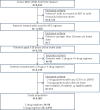Characteristics of 2-drug regimen users living with HIV-1 in a real-world setting: A large-scale medical claim database analysis in Japan
- PMID: 35700215
- PMCID: PMC9197042
- DOI: 10.1371/journal.pone.0269779
Characteristics of 2-drug regimen users living with HIV-1 in a real-world setting: A large-scale medical claim database analysis in Japan
Abstract
Background: Regimen simplification to 2-drug antiretroviral therapy (2-ART) may address potential tolerability issues, increase adherence, and reduce toxicity and potential drug-drug-interactions among people living with HIV-1 (PLWH). However, real-world treatment patterns and characteristics of 2-ART users are unclear.
Methods: This retrospective observational cohort study employed a large-scale medical claim database of Japanese hospitals to extract data on 4,293 PLWH aged ≥18 years with diagnosis of HIV and treated with any ART regimens between April 2008 and April 2019. A 2-ART cohort was compared with a 3-drug antiretroviral therapy (3-ART) cohort in terms of population characteristics, comorbid conditions, and treatment patterns. Treatment switching rates were calculated for each cohort followed by sensitivity analysis to confirm the robustness of the findings.
Results: There were 94 individuals identified in the 2-ART cohort. Compared to the standard 3-ART cohort (n = 3,993), the 2-ART cohort was older (median age 53 [IQR 44-64] vs 42 years [IQR 35-50]), with a lower proportion of males (87.2% vs 93.8%), higher Charlson Comorbidity Index (CCI) (median score 6 [IQR 5-8] vs 5 [IQR 4-6]), more co-medications (median 6 [IQR 4-11] vs 3 [IQR 2-7]), and a higher percentage of AIDS-defining conditions (66.0% vs 42.8%). The most common 2-ART were protease inhibitor (PI) + integrase strand transfer inhibitor (INSTI) and non-nucleoside reverse transcriptase inhibitor (NNRTI) + INSTI (33.0% and 31.9%, respectively). Overall, most of the regimens were nucleoside reverse transcriptase inhibitor (NRTI)-sparing (71.3%), with a decreasing trend over time (76.2% to 70.2%). ART regimen switch occurred more often in the 2-ART cohort than in the 3-ART cohort (33.0% vs 21.2%).
Conclusion: The profiles of individuals on 2-ART in Japan were demonstrated to be complex. Most were treated with NRTI-sparing regimens which may reflect an effort to reduce treatment-related toxicities.
Conflict of interest statement
This study is a company sponsored study, employed authors DJR, NK, NO, MK, MY received salaries and the manuscript was reviewed by company to meet scientific criteria and meet with our areas of interest as a company. SO received research budget from ViiV healthcare and Gilead Sciences, and honorarium for lectures from ViiV Healthcare, Gilead Sciences, and MSD K.K.. Authors contribution for authors employed by the funding organization is described in "Author Contributions". The funding organization did not interfere with study design, data collection and analysis, nor the decision to publish and has an ethical guideline to always publish after a study has been conducted regardless of the outcome of the results. This does not alter our adherence to PLOS ONE policies on sharing data and materials
Figures


Similar articles
-
Switch rates, time-to-switch, and switch patterns of antiretroviral therapy in people living with human immunodeficiency virus in Japan, in a hospital-claim database.BMC Infect Dis. 2019 Jun 10;19(1):505. doi: 10.1186/s12879-019-4129-6. BMC Infect Dis. 2019. PMID: 31182050 Free PMC article.
-
Weight gain following switch to integrase inhibitors from non-nucleoside reverse transcriptase or protease inhibitors in people living with HIV in the United States: analyses of electronic medical records and prescription claims.Curr Med Res Opin. 2023 Sep;39(9):1237-1246. doi: 10.1080/03007995.2023.2239661. Epub 2023 Aug 10. Curr Med Res Opin. 2023. PMID: 37480288
-
Weight gain after antiretroviral therapy initiation in people living with HIV in the United States: analyses of electronic medical records and prescription claims.Curr Med Res Opin. 2023 Jul;39(7):997-1006. doi: 10.1080/03007995.2023.2224165. Epub 2023 Jun 24. Curr Med Res Opin. 2023. PMID: 37334707
-
Switching regimens in virologically suppressed HIV-1-infected patients: evidence base and rationale for integrase strand transfer inhibitor (INSTI)-containing regimens.HIV Med. 2016 Oct;17 Suppl 5:3-16. doi: 10.1111/hiv.12440. HIV Med. 2016. PMID: 27714978 Review.
-
Executive summary of the GESIDA/National AIDS Plan Consensus Document on antiretroviral therapy in adults infected by the human immunodeficiency virus (updated January 2015).Enferm Infecc Microbiol Clin. 2015 Oct;33(8):544-56. doi: 10.1016/j.eimc.2015.03.017. Epub 2015 May 26. Enferm Infecc Microbiol Clin. 2015. PMID: 26021186
References
-
- Nation Institutes of Health. Guidelines for the Use of Antiretroviral Agents in Adults and Adolescents with HIV. 2019. [cited 2020 March 4]. Available from: https://files.aidsinfo.nih.gov/contentfiles/lvguidelines/AA_Recommendati....
-
- Consolidated guidelines on the use of antiretroviral drugs for treating and preventing HIV infection: recommendations for a public health approach. 2016. [cited 2020 March 4]. Available from: https://apps.who.int/iris/bitstream/handle/10665/208825/9789241549684_en.... - PubMed
Publication types
MeSH terms
Substances
LinkOut - more resources
Full Text Sources
Medical
Research Materials
Miscellaneous

